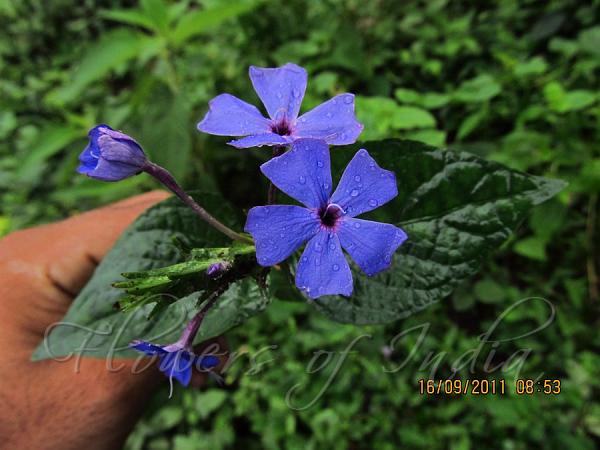|
| Purple Eranthemum |
|

|

|
|
|
|
Photo: |
Botanical name: Eranthemum purpurascens Family: Acanthaceae (Acanthus family)
Synonyms: Daedalacanthus purpurascens
Synonyms: Daedalacanthus purpurascens
Purple Eranthemum is a herb to undershrub, up to 3 ft tall,
stem 4-angled, striped, shortly velvet-hairy.
Flowers are borne in spikes
at branch-ends and in leaf-axils, 7 cm long, flower-cluster-stalk up
to 10 cm long. Flowers are blue, 4 cm long, tube long and slender,
petals obovate, twisted to the left in bud, spreading in flower, perfect
stamens 2, staminodes 2; style long and slender, sparsely hairy. Sepal-cup
is scarious, 12 x 1 mm, oblong-lanceshaped with long pointed sepals 5.
Bracts are green, ovate-lanceshaped, to 2.5 cm long, long tapering,
prominently nerved, netveined, margin fringed with hairs. Leaves ovate or
elliptic, 4-10 x 2.5-8 cm, becoming hairless, base rounded and
then decurrent, somewhat heart-shaped in upper stalkless ones,
margin rounded-toothed, tip tapering; lateral nerves up to 8 pairs,
prominent. Leaf-stalk is decurrent, 3.5 cm, upper leaves much smaller than
the lower ones, heart-shaped, rounded or narrowed at base, stalkless
or shortly stalked. Capsule is 1-1.2 cm long, club-shaped-oblong,
painted, hairless. Purple Eranthemum is found in the Himalayas, Western
Ghats and other parts of India, at altitudes of 300-1700 m. Flowering:
November-February.
| Identification credit: Gurcharan Singh | Photographed in Chakrata, Uttarakhand. |
• Is this flower misidentified? If yes,